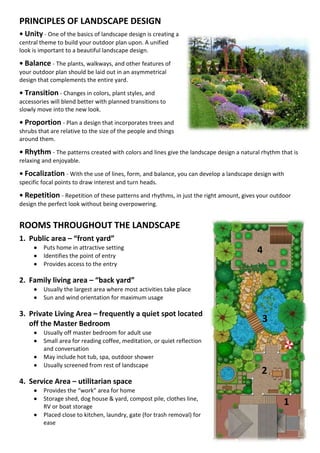Getting My Landscape Design To Work
Wiki Article
How Landscape Design can Save You Time, Stress, and Money.
Table of ContentsThe 4-Minute Rule for Landscape DesignUnknown Facts About Landscape DesignA Biased View of Landscape DesignSome Ideas on Landscape Design You Need To Know
A backyard can usually be divided right into three locations: public (the front backyard), private (the back lawn), and service (generally the side backyard). The area of activity areas depends largely on the type of area, the size of room required, the kind of activity, and the desired closeness to other tasks and frameworks.
The outside wall surface of your house often offers as the very first wall surface or beginning point of an exterior area. Inappropriate uses should be divided, and related tasks, such as cooking and dining, must be placed together to make the lawn extra reliable and pleasurable. When utilizing hardscape to create rooms, make use of construction product comparable to that utilized in your house for connection from your house right into the garden.
Linked rooms. Credit Score: Gail Hansen, UF/IFAS Making use of similar hardscape features and duplicating plants pulls the eye around the yard. Vital factors in the process can be stressed with plantings or features that attract interest and motivate motion in a specific direction. Moving along the course takes an individual from one area to the next and enables the individual to have a variety of experiences.
From a style viewpoint, plant products have three significant functions in the landscape: aesthetic, architectural and practical. Cosmetically, plants create an aesthetically enjoyable atmosphere and structurally plants arrange and specify areas.
Get This Report about Landscape Design
For mental comfort plants are used as physical or suggested obstacles for privacy and security. Physical barriers obstruct both the sight and access to a space and consist of fences, wall surfaces and plant bushes. Landscape Design. Implied obstacles, commonly reduced growing plants, block accessibility but not the view (Figure 9). Various other functions of plants include cleaning up the air, stopping erosion and soil loss, maintaining wetness in the dirt, and returning organic matter to the soil.Physical and suggested barriers. Debt: Gail Hansen, UF/IFAS For these factors, the types of plants to be used (such as trees, bushes, or groundcovers) ought to be picked in the very early stages of planning. Plant kinds are chosen for their useful capabilities to ensure that their future objective and required space can be thought about at the very same time.
The overhanging airplane, the vertical aircraft and the ground plane must all be thought about to develop enclosure. As soon as the shape of a plant bed has been established, the plants should be massed (organized) and split to accomplish visual unity and the preferred quantity of unit. The size of a plant mass will certainly rely on the total size of the yard, the dimension of the private plants in the visit this website mass, and the focus or impact preferred from the plant product.
Each plant anchor mass remains in front of, behind, or beside, another mass. Number 11. Straight plant layers. Credit Score: Gail Hansen, UF/IFAS Number 12. Upright plant layers. Credit: Gail Hansen, UF/IFAS Duplicating plants within a mass and duplicating masses with similar plants links the garden with each other. The private plant attributes have to be thought about to efficiently layer and mass plants.
The Ultimate Guide To Landscape Design
All plant compositions start with the primary framework plants, the huge, primarily evergreen background plants-such as the trees and big shrubs. These plants different or enframe rooms, manage the size of the room, and offer the beginning point for selecting the appropriate features of the second layer, midground plants, for massing and infill.
Crucial factors in the garden need to be highlighted by the use unique plants, distinct frameworks, or garden accessories. Marking thresholds or entrances to areas can be made with gates, arbors, and actions, or through the use of unique and colorful plants. The type and/or design read this article theme of the yard will certainly commonly aid identify the essential factors and just how they need to be highlighted.
Various other crucial locations in the lawn are focal factors, which is used to aesthetically organize a landscaped area. The type of centerpiece commonly relies on the viewing viewpoint. Different perspectives or point of views can disclose various make-ups in the landscape that may require a selection of centerpieces. Contrasting structure, form, dimension and shade will certainly catch and hold the eye.
The Greatest Guide To Landscape Design
Figure 13. Plant types. Credit Scores: Gail Hansen, UF/IFAS After kind, texture is the next leading feature of a plant; coarse, tool and fine textures can be used for comparison and focus in the landscape. Form and appearance both trump color in the garden for most of the year. Throughout specific seasons, shade will be the most recognizable feature of the garden.

The pleasurable scent of plants, the noise of wind in the trees, the noise and appearance of water, and the colors and appearances of sculptures, pots and garden furniture all include in the experience of the garden. One information that is usually forgotten is the impact of light on the appearances of the plants.
The whole garden changes in function and appearance throughout the day, and the training course of a year, as the light and temperature level change from morning to evening and period to season. Plant selection must consider a plant's growth price, its mature dimension and kind, and the maintenance it will certainly call for.
It is very important to understand the eventual fully grown dimension of plants so they can be put in the right location and spaced appropriately when they are mounted. Offering plants room to grow is a challenge since the typical fully grown size is typically based on ideal growing problems and the environmental conditions of a website may trigger a plant to expand bigger or stay smaller.
Report this wiki page